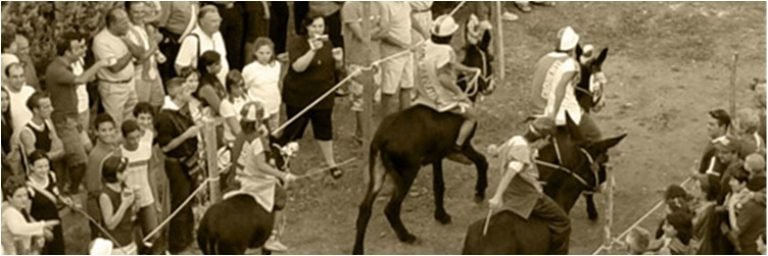It may not be known as the Palio di Siena, but it is precisely from the competition in the form of a Tuscan equestrian joust that the Palio cu i ciucci originates, which has been animating the challenge between the contradas of the town of Laino Borgo for 22 editions. The Laino man, Settimo Rossi, married to a contradaiola from Siena, decided to replicate it, Calabrian-style, and in 1976 began the competition between the districts that make up the town in the Pollino National Park, which, instead of horses, use donkeys for the race, challenging each other in a community-flavoured horse joust.
This enthralling tournament between the Cagghienti (twinned with Mauriani), Casalettu Vavuosu (twinned with Scala), 'Mbedi u burgu (twinned with Iannieddu), Sant'Antonio (twinned with Vuccalupu Pidali) districts returns on 12 and 13 August, Sant'Agustinu (twinned with Chianetti), San Biasu (twinned with San Primu and Santo Ianni), Santu Vastianu (twinned with 'Ncanica) who will compete for the final victory in a two-day event involving all citizens. Organised by the Pro Loco with the patronage and financial support of the municipal administration, the event has gone from being a local event to becoming a major attraction, attracting tourists, the curious, and fans of the genre to the city.
In the best tradition of the palio, the evening before the race there is the traditional 'eve dinner', during which the districts gather together to eat traditional country dishes: pasta and beans, stew with peppers, roast sausage, fusilli, tripe, pork rind and beans. A rendezvous with local gastronomy useful for promoting the 'fagiolo poverello' bean.
For the competitive aspect, however, the race is declared the winner when one of the dummies completes the entire three laps of the field envisaged within the competition perimeter created in the market area of the municipality of Laino Borgo, near the Town Hall, which is set up with a beaten earth ground and bordered by straw bales in full respect of the competing animals. The winner, however, is also the so-called shaken dummy, i.e. the dummy that crosses the finishing line first (after the regulation three laps) without its jockey.
The Palio cu i Ciucci
Type
No info.
Place
Laino Borgo
